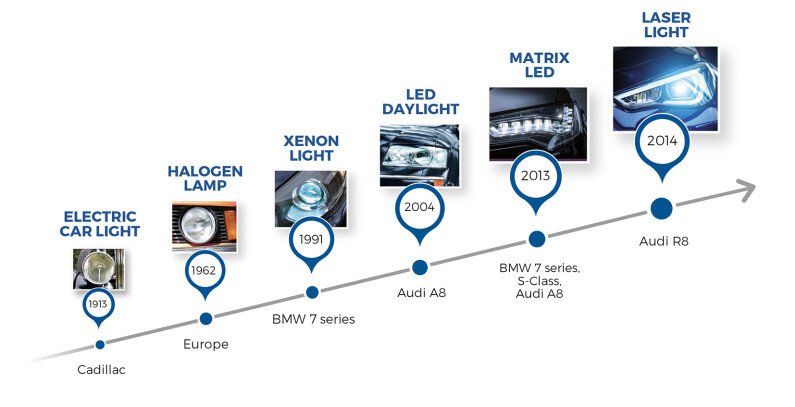The Evolution of the Headlamp

By Simon Ramsdale, Analog Products – European and Automotive Marketing Manager
The last two decades have seen significant change in automotive lighting, an evolution that is particularly noticeable in the area of forward lighting. Headlights have evolved from simple ‘on/off’, uni-directional lamps to more adaptive lighting solutions and it is an evolution that has accelerated noticeably since the development of LEDs for the automotive market. Over their entire lifetime – some 100 years – headlights have changed in large part to meet new safety requirements, but in the last 20 years those changes have been motivated by other factors, such as performance, efficiency, reliability and styling. In this respect it is no coincidence that these are all areas where LEDs have offered great potential for advancements.
For example, with respect to performance and reliability, headlights have advanced from incandescent and halogens bulbs to LEDs and adaptive beamforming. In the 1960s halogen headlamps were introduced, which produced a clearer, brighter and more powerful beam, providing greater projection of distance. The next step in the evolution was the Xenon ‘High Intensity Discharge’ bulb which dramatically improved the light output of the headlamp, and for some high-end manufactures become the technology of choice. The introduction of LED lamps at the beginning of this century improved on the Xenon ‘High Intensity Discharge’ bulb, and at the time this evolutionary step came without much effect on efficiency. However, further developments in LED technology has allowed the cost and efficiency of LED headlamps to surpass HID.
The development of adaptive beamforming in headlamps represents another significant step in their evolution. Adaptive beamforming takes forward lighting one stage further, allowing the light beams to actually change direction using ‘steerable’ beams of light. Implementations vary but it is typically achieved by turning selected LEDs on and off. This greatly increases the performance of the forward light while dramatically improving safety, not least by reducing dazzle for oncoming vehicles. Adaptive beamforming headlamps vary enormously in complexity and can comprise as few as nine to over 80 LEDs. Diodes offers a number of solutions for this application space, such as its boost (ZXLD1371Q) and buck (ZXLD1366Q) LED drivers designed to provide the constant current drive required by LEDs, coupled with transistor switches that can be used to remove power or bypass the LEDs when they need to be off.
One of the most successful applications of LED technology for front lamps is the Daytime Running Lamp (DRL). These are forward-facing lights that are intended to remain on all the while the car is in use; note, that isn’t simply when the car is moving or the engine is running, as DRLs will typically stay on even if stop-start technology (cutting the engine when stationary) is being used.
The main driving force behind adopting LEDs for DRLs is the efficiency gains they offer over plain incandescent lamps. However, more recent developments have seen the flexibility of LEDs also being exploited for styling purposes, which includes applying branding through the shape of the light coming from the DRL; many cars are now instantly recognizable from their DRL.
The combination of always-on DRLs and stop-start technology puts particular demands on the electronics used. The low levels and wide variation in the operating voltage within the car (6V to 19V steady state, with 40V surge or peak protection) creates unique requirements for the DC-DC converters developed to drive the LEDs. Diodes’ ZXLD1371Q has proven successful as an LED driver of choice for many manufacturers implementing DRLs, thanks to its ability to operate reliably from a supply ranging from 5V up to 60V.
Another area where the benefits of LEDs have been felt is in the rear cluster. These lights generally use less current than forward facing lights and have primarily been adopted because of their efficiency and reliability. Typically, the LED drivers would be linear rather than switching, which are less expensive and produce less EMI. This has also encouraged manufacturers to use the rear cluster as another chance to apply their branding through styling and other functionality.
Efficiency remains the main benefit of LED lighting, which is why it has been applied to the two areas where most gains can be made; DRLs and rear clusters. Their use in front facing lights and adaptive beamforming delivers safety and efficiency benefits, while in rear clusters they provide greater reliability while consuming less energy. Thanks to its broad portfolio of automotive-qualifies solutions, Diodes is also a driving force in automotive lighting.
